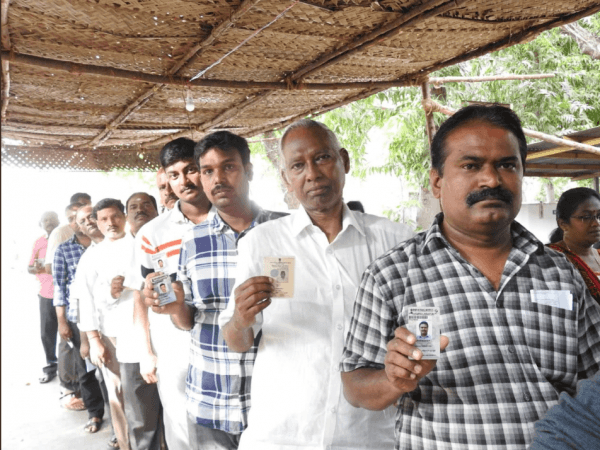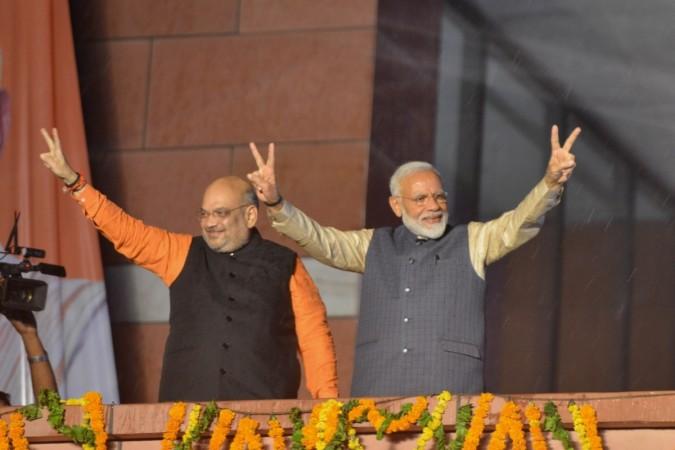
The worlds largest elections in terms of sheer numbers throw up a lot of macro number trends, including the fact that the largest party -- Bharatiya Janata Party (BJP) -- has been able to create a new voter base defined by economic class rather than by caste or religion.
This Lok Sabha elections, the people of India voted in record numbers with a combined voter turnout of 67.11 per cent, higher than the previous record of 66.4 per cent in 2014. Rising voter participation is always a good sign of the vibrancy of democracy. There are other microtrends which reveal the depth and density of the Modi wave.
Expectations and Results
Liberal commentators sitting in metros predicted that the National Democratic Alliance (NDA) government would have a tough battle on its hands. They said it was impossible for NDA/BJP to repeat its stellar performance of 2014, it has to cede ground. Though I had spoken in the first week of April about a new Modi wave arising, not many believed it or accepted it.
In what was a historic election, the final results were a sweet vindication for the exit pollsters. It is important to see the rise in vote share for the NDA which has jumped from 38.3 per cent in 2014 to 43.8 per cent in 2019, a rise of 5 per cent. The absolute vote share is the highest in the last three elections for a ruling coalition and the jump of vote share and the huge difference with UPA (vote share of 26.9 per cent) show the depth of the mandate.
As a party, the vote share for the BJP shows that it has maintained its geographical footprint, increased its rural vote share and most importantly, added the poor and backward classes in its vote share. These are important demographic changes in the BJP's vote share which were earlier spread across smaller regional parties or went to the Congress/United Progressive Alliance (UPA).
While the vote share has not resulted in seat share in every region, the rise of vote share has been there in all regions. Even in the North, South and West, where the NDA has reduced its seat share marginally, its vote share has gone up dramatically in these regions. Which means that people have been influenced and affected by the BJP's election campaign more than by any other party. This has important learnings for all the opposition parties who derided the BJP for the lack of its connection with the common man.
If one analysis the geographical share of the vote share across North, South, West, East, Central and North East regions, the change in seat share and the change in aggregate vote share provides a good insight into the party's performance across the country.
In the North, the NDA lost only 8 seats as compared to the 2014 tally, losing 9 seats in Uttar Pradesh and 2 in Punjab, while gaining 3 new seats in Haryana. The NDA has been able to increase its base here with its vote share rising to 49 per cent. The rise in seat share and vote share is much more important for Haryana as the state goes to the polls in three month's time. Currently led by Chief Minister Manohar Lal Khattar, a non-Jat leader, the state BJP will fight the elections on Modi's name.
The caste arithmetic of the Samajwadi Party-Bahujan Samaj Party-Rashtriya Lok Dal (SP-BSP-RLD) alliance saw a 7 per cent fall in vote share, indicating the weakness of the coalition, especially in terms of transferability of votes between the two former archrivals. However, they did manage to win 2 additional seats, largely due to the relative success of the BSP compared to the previous elections in Uttar Pradesh. BSP-SP-RLD did not even bother to prepare a manifesto as BSP supremo Mayawati has believed that people vote for her, and not what she promises. The SP too did not have a clear set of things that it was taking to the electorate.
The southern states were crucial to the UPA, and Rahul Gandhi won from Wayanad in Kerala. The UPA's tally of 23 seats in 2014 grew to 60. Due to its robust performance in Kerala, the Congress bagged 15 of 20 seats there while M.K. Stalin's DMK won 23 seats in Tamil Nadu. The vote share of UPA also rose from 23.9 per cent to 26.8 per cent. This was the silver lining in an otherwise forgettable election for the UPA. This signals a shift away from a pan-India party to a largely South India's party.

The West was dominated once more by the NDA, which for the second time in a row secured all the 26 seats in Gujarat as well as 41 of the 48 seats in Maharashtra. The NDA increased its vote share by about 3 per cent in Gujarat and it remained steady in Maharashtra at 51.2 per cent.
An Eastward Political Coup
NDA increased its vote share in the East by 17 per cent over 2014 -- nearly twice the increase in the Northern region. The UPA saw a fall of 13 per cent of its vote share, which was transferred by voters to the NDA. The NDA's strategy paid off bringing 29 additional seats into its fold, including 8 in Bihar, 7 in Odisha and a massive 16 seats in West Bengal.
In Odisha, the Biju Janata Dal (BJD) has also lost ground with their seat tally falling from 20 in 2014 to just 12 in 2019, and the BJP increasing its tally from 1 to 8, particularly in the West and North of Odisha. The BJP won 7 of their 8 seats in potato growing parliamentary constituencies, the eighth being Bhubaneshwar. Koratput, which was the sole seat the Congress won, interestingly, is also a potato growing belt.
The Minority Vote
Contrary to popular perception, the BJP-led NDA seems to have swayed the minorities. The NDA received nearly twice the vote share of the Congress in constituencies that had minorities accounting for under 40 per cent of the total population (Muslims+Christians+SC+ST), or low minority seats.
The NDA had secured a favourable outcome in 213 or 69 per cent of the seats in 2014, with a vote share of 41.4 per cent. The Congress won a paltry 19 seats, just 4.5 per cent of the constituencies with a vote share of 22.9 per cent.
In 234 seats where the total minority population is greater than 40 per cent (or high minority seats), the vote share split was more equitable with the NDA securing the highest vote share of 34.3 per cent. The NDA converted a higher portion of seats, winning 123 or 53 per cent of these seats which could also be due to Hindu vote consolidation.
In 2014, the UPA won 41 seats but it had the lowest vote share of 25.1 per cent with other parties receiving 30.7 per cent of the total vote. The 3.5 per cent vote share difference between the NDA and the other parties led to a higher seat share of almost 53 seats in 2014.

In 2019, the Modi wave shows that the 2014 results were no aberration, and a tectonic shift is taking place in Indian politics. Going by the data, the NDA was victorious in 141 of the 234 high minority seats, an increase of 18 such seats. Importantly, the NDA's vote share rose significantly from 34.3 per cent to 41.9 per cent, dwarfing both that of the UPA and the regional parties.
In fact, the NDA lost seats in low minority constituencies. In Bihar too, the Janata Dal (United) increased its tally from 2 to 16 seats, with 10 of these seats having a Muslim population of 10-20 per cent. The JD(U) also won 4 of 7 seats that have a high minority population, while the BJP won 2, and the Congress won a single seat.
Odisha too is a key case in demonstrating that the NDA, and particularly the BJP, has not only engineered an Eastward expansion but more importantly it is the new party for the minorities. Eleven seats in the state were high minority areas. In 2014, the BJP won only Sundargarh (one of only two semi-urban seats in the state) by a slender 1.8 per cent margin. BJP President Amit Shah decided almost three years back to target Odisha, in which the party secured 6 of these 11 seats. The vote share of the BJD has gone up by 0.2 per cent in these high minority seats. However, this is likely to be highly concentrated, whereas the BJP has increased its vote share by nearly 14 per cent in the region, and the UPA fell nearly 10 per cent to settle at 18.5 per cent.
The NDA's performance shows that it is growing its vote share across India and it has moved beyond its traditional vote bank of traders and urban voters. The common voter believes in the delivery given by the BJP government in terms of schemes like Ujjwala and Swachh Bharat, which is more than any other Central government has done in the past.









!['Had denied Housefull franchise as they wanted me to wear a bikini': Tia Bajpai on turning down bold scripts [Exclusive]](https://data1.ibtimes.co.in/en/full/806605/had-denied-housefull-franchise-they-wanted-me-wear-bikini-tia-bajpai-turning-down-bold.png?w=220&h=138)



